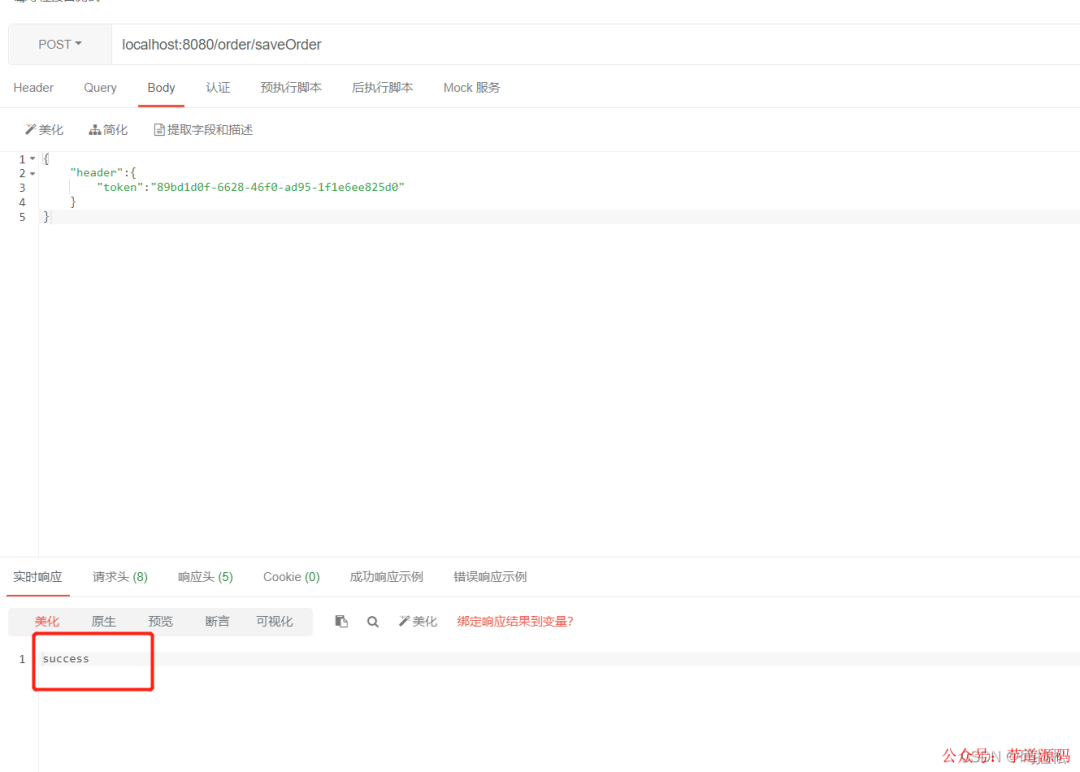

一个注解,优雅的实现接口幂等性!
电子说
描述
一、什么是幂等性?
简单来说,就是对一个接口执行重复的多次请求,与一次请求所产生的结果是相同的,听起来非常容易理解,但要真正的在系统中要始终保持这个目标,是需要很严谨的设计的,在实际的生产环境下,我们应该保证任何接口都是幂等的,而如何正确的实现幂等,就是本文要讨论的内容。
基于 Spring Boot + MyBatis Plus + Vue & Element 实现的后台管理系统 + 用户小程序,支持 RBAC 动态权限、多租户、数据权限、工作流、三方登录、支付、短信、商城等功能
- 项目地址:https://github.com/YunaiV/ruoyi-vue-pro
- 视频教程:https://doc.iocoder.cn/video/
二、哪些请求天生就是幂等的?
首先,我们要知道查询类的请求一般都是天然幂等的,除此之外,删除请求在大多数情况下也是幂等的,但是ABA场景下除外。
举一个简单的例子
比如,先请求了一次删除A的操作,但由于响应超时,又自动请求了一次删除A的操作,如果在两次请求之间,又插入了一次A,而实际上新插入的这一次A,是不应该被删除的,这就是ABA问题,不过,在大多数业务场景中,ABA问题都是可以忽略的。
除了查询和删除之外,还有更新操作,同样的更新操作在大多数场景下也是天然幂等的,其例外是也会存在ABA的问题,更重要的是,比如执行update table set a = a + 1 where v = 1这样的更新就非幂等了。
最后,就还剩插入了,插入大多数情况下都是非幂等的,除非是利用数据库唯一索引来保证数据不会重复产生。
基于 Spring Cloud Alibaba + Gateway + Nacos + RocketMQ + Vue & Element 实现的后台管理系统 + 用户小程序,支持 RBAC 动态权限、多租户、数据权限、工作流、三方登录、支付、短信、商城等功能
- 项目地址:https://github.com/YunaiV/yudao-cloud
- 视频教程:https://doc.iocoder.cn/video/
三、为什么需要幂等
1.超时重试
当发起一次RPC请求时,难免会因为网络不稳定而导致请求失败,一般遇到这样的问题我们希望能够重新请求一次,正常情况下没有问题,但有时请求实际上已经发出去了,只是在请求响应时网络异常或者超时,此时,请求方如果再重新发起一次请求,那被请求方就需要保证幂等了。
2.异步回调
异步回调是提升系统接口吞吐量的一种常用方式,很明显,此类接口一定是需要保证幂等性的。
3.消息队列
现在常用的消息队列框架,比如:Kafka、RocketMQ、RabbitMQ在消息传递时都会采取At least once原则(也就是至少一次原则,在消息传递时,不允许丢消息,但是允许有重复的消息),既然消息队列不保证不会出现重复的消息,那消费者自然要保证处理逻辑的幂等性了。
四、实现幂等的关键因素
关键因素1
幂等唯一标识,可以叫它幂等号或者幂等令牌或者全局ID,总之就是客户端与服务端一次请求时的唯一标识,一般情况下由客户端来生成,也可以让第三方来统一分配。
关键因素2
有了唯一标识以后,服务端只需要确保这个唯一标识只被使用一次即可,一种常见的方式就是利用数据库的唯一索引。
五、注解实现幂等性
下面演示一种利用Redis来实现的方式。
1.自定义注解
import java.lang.annotation.ElementType;
import java.lang.annotation.Retention;
import java.lang.annotation.RetentionPolicy;
import java.lang.annotation.Target;
@Target(value = ElementType.METHOD)
@Retention(RetentionPolicy.RUNTIME)
public @interface Idempotent {
/**
* 参数名,表示将从哪个参数中获取属性值。
* 获取到的属性值将作为KEY。
*
* @return
*/
String name() default "";
/**
* 属性,表示将获取哪个属性的值。
*
* @return
*/
String field() default "";
/**
* 参数类型
*
* @return
*/
Class type();
}
2.统一的请求入参对象
@Data
public class RequestData<T> {
private Header header;
private T body;
}
@Data
public class Header {
private String token;
}
@Data
public class Order {
String orderNo;
}
3.AOP处理
import com.springboot.micrometer.annotation.Idempotent;
import com.springboot.micrometer.entity.RequestData;
import com.springboot.micrometer.idempotent.RedisIdempotentStorage;
import org.aspectj.lang.ProceedingJoinPoint;
import org.aspectj.lang.annotation.Around;
import org.aspectj.lang.annotation.Aspect;
import org.aspectj.lang.annotation.Pointcut;
import org.aspectj.lang.reflect.MethodSignature;
import org.springframework.stereotype.Component;
import javax.annotation.Resource;
import java.lang.reflect.Method;
import java.util.Map;
@Aspect
@Component
public class IdempotentAspect {
@Resource
private RedisIdempotentStorage redisIdempotentStorage;
@Pointcut("@annotation(com.springboot.micrometer.annotation.Idempotent)")
public void idempotent() {
}
@Around("idempotent()")
public Object methodAround(ProceedingJoinPoint joinPoint) throws Throwable {
MethodSignature signature = (MethodSignature) joinPoint.getSignature();
Method method = signature.getMethod();
Idempotent idempotent = method.getAnnotation(Idempotent.class);
String field = idempotent.field();
String name = idempotent.name();
Class clazzType = idempotent.type();
String token = "";
Object object = clazzType.newInstance();
Map paramValue = AopUtils.getParamValue(joinPoint);
if (object instanceof RequestData) {
RequestData idempotentEntity = (RequestData) paramValue.get(name);
token = String.valueOf(AopUtils.getFieldValue(idempotentEntity.getHeader(), field));
}
if (redisIdempotentStorage.delete(token)) {
return joinPoint.proceed();
}
return "重复请求";
}
}
import org.aspectj.lang.ProceedingJoinPoint;
import org.aspectj.lang.reflect.CodeSignature;
import java.lang.reflect.Field;
import java.util.HashMap;
import java.util.Map;
public class AopUtils {
public static Object getFieldValue(Object obj, String name) throws Exception {
Field[] fields = obj.getClass().getDeclaredFields();
Object object = null;
for (Field field : fields) {
field.setAccessible(true);
if (field.getName().toUpperCase().equals(name.toUpperCase())) {
object = field.get(obj);
break;
}
}
return object;
}
public static Map getParamValue(ProceedingJoinPoint joinPoint) {
Object[] paramValues = joinPoint.getArgs();
String[] paramNames = ((CodeSignature) joinPoint.getSignature()).getParameterNames();
Map param = new HashMap<>(paramNames.length);
for (int i = 0; i < paramNames.length; i++) {
param.put(paramNames[i], paramValues[i]);
}
return param;
}
}
4.Token值生成
import com.springboot.micrometer.idempotent.RedisIdempotentStorage;
import com.springboot.micrometer.util.IdGeneratorUtil;
import org.springframework.web.bind.annotation.RequestMapping;
import org.springframework.web.bind.annotation.RestController;
import javax.annotation.Resource;
@RestController
@RequestMapping("/idGenerator")
public class IdGeneratorController {
@Resource
private RedisIdempotentStorage redisIdempotentStorage;
@RequestMapping("/getIdGeneratorToken")
public String getIdGeneratorToken() {
String generateId = IdGeneratorUtil.generateId();
redisIdempotentStorage.save(generateId);
return generateId;
}
}
public interface IdempotentStorage {
void save(String idempotentId);
boolean delete(String idempotentId);
}
import org.springframework.data.redis.core.RedisTemplate;
import org.springframework.stereotype.Component;
import javax.annotation.Resource;
import java.io.Serializable;
import java.util.concurrent.TimeUnit;
@Component
public class RedisIdempotentStorage implements IdempotentStorage {
@Resource
private RedisTemplate redisTemplate;
@Override
public void save(String idempotentId) {
redisTemplate.opsForValue().set(idempotentId, idempotentId, 10, TimeUnit.MINUTES);
}
@Override
public boolean delete(String idempotentId) {
return redisTemplate.delete(idempotentId);
}
}
import java.util.UUID;
public class IdGeneratorUtil {
public static String generateId() {
return UUID.randomUUID().toString();
}
}
5. 请求示例
调用接口之前,先申请一个token,然后带着服务端返回的token值,再去请求。
import com.springboot.micrometer.annotation.Idempotent;
import com.springboot.micrometer.entity.Order;
import com.springboot.micrometer.entity.RequestData;
import org.springframework.web.bind.annotation.RequestBody;
import org.springframework.web.bind.annotation.RequestMapping;
import org.springframework.web.bind.annotation.RestController;
@RestController
@RequestMapping("/order")
public class OrderController {
@RequestMapping("/saveOrder")
@Idempotent(name = "requestData", type = RequestData.class, field = "token")
public String saveOrder(@RequestBody RequestData requestData) {
return "success";
}
}
请求获取token值。

带着token值,第一次请求成功。

第二次请求失败。

-
在高并发下怎么保证接口的幂等性?2021-05-14 2281
-
注解定义Bean及开发2022-08-02 667
-
什么是幂等性?关于接口幂等性的解决方案2022-10-09 2504
-
Spring Boot实现接口幂等性的4种方案2022-11-08 1427
-
如何设计一个优雅的API接口2022-12-20 2281
-
什么是幂等性?幂等的实现原理2023-01-05 7397
-
如何实现一个注解进行数据脱敏2023-06-14 1553
-
基于接口幂等性解决方案2023-09-30 822
-
接口统一异常优雅处理介绍及实战2023-10-22 1229
-
为什么要实现幂等性校验 如何实现接口的幂等性校验2024-02-20 2003
-
探索LabVIEW编程接口幂等性原理与实践2024-02-29 1470
-
如何秒级实现接口间“幂等”补偿:一款轻量级仿幂等数据校正处理辅助工具2025-09-15 687
全部0条评论

快来发表一下你的评论吧 !

